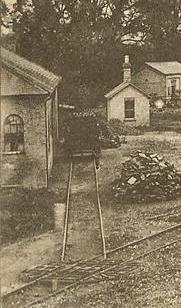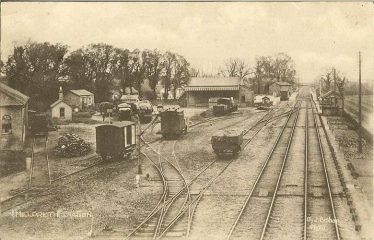The Large Warehouse








This building (occupied until recently by Gocold) has a very chequered history and has been used for a most interesting hotchpotch of uses. The present building dates from c.1901 (see accompanying diagrams) but it appears to be a modification of an earlier, possibly smaller, building as the diagram refers to ‘present store’ and ‘old engine house’ etc.
The north end of the building used to be a house, occupied over the years by various railway personnel, e.g. the station master, the goods yard manager etc. This was fronted by a small garden.
The remainder of the building was divided into four, large ‘rooms’ which have been used for various purposes over the years. In 1945 the first two were used to store coal. This was both in bags but also coal dust was pressed into briquettes and stored ready for distribution.
The third room was a coprolite store, still full in 1945 even though coprolite mining ceased towards the end of the C19th. Coprolite is a mixture of dinosaur dung and phosphatic nodules which was mined in Whaddon as well as other areas in South Cambridgeshire. A gable was originally built into the roof of the warehouse facing Station Road and was used to hoist up sacks of coprolite for transfer into a coprolite mill which ground it into a fine powder. The gable can be seen on 1945 photographs but it has since been removed.
The final, small, fourth ‘room’ at the far end of the building housed a water tank and a wind-driven water pump. This raised water from an underground well and was used to supply water to the house at the end of the warehouse, the station and Allerton Terrace. The water pump was driven by an eight vaned wind turbine situated on the roof.
At the far, south end of the building were two toilets situated in a lean-to against the back wall. These would have been earth toilets at the time of building.
Railway wagons were moved by horses on a siding which ran in front of the warehouse. A mechanically operated turntable was needed to turn the wagons through the sharp angle from the main railway sidings. It is probable that the warehouse was also used at one time for the transhipment of cement materials from the Atlas Stone Company which were delivered to the yard by Puffing Billy. Puffing Billy was not actually allowed into the goods yard. The horses moved the wagons in and out of the yard.
The siding in front of the warehouse was removed sometime after 1945. It is present on an aerial photo taken by the US air force in 1945 but was absent on the later 1961 aerial survey.
I am indebted to Ken Winter and Brian Pepper for their memories of the goods yard and its buildings. If you have any more information or memories of this area I would be most interested to hear from you. Please add a comment below.





Comments about this page
Thanks for your comment Bernard. Unfortunately I don’t know the owner of the mill. The information re. a mill being sited in one of the buildings in the station yard came from your very informative book: The 19th century Coprolite industry around Meldreth, Cambridgeshire. Local residents remember that coprolite was still stored in this warehouse in the mid twentieth century and with the gable on the roof for the offloading of the coprolite this building is the most likely location for a mill. The position of the sidings also make this a likely position for loading the milled coprolite for transhipment.
To find out more on the coprolite industry, readers may be able to find people who attended my talk on the fossil diggers to the Royston & District Family History Society in Melbourn on Monday 16th May 2011, visit the coprolite pages on my website: http://www.bernardoconnor.org.uk or get hold of a copy of my books on the diggings.
Might you know who owned the coprolite mill?
Add a comment about this page